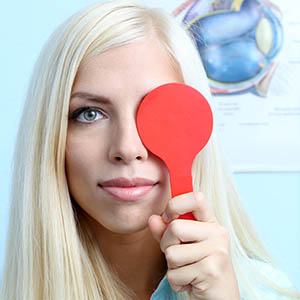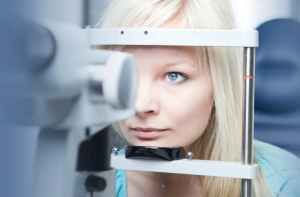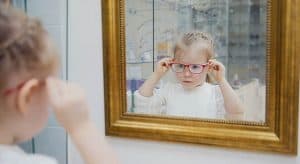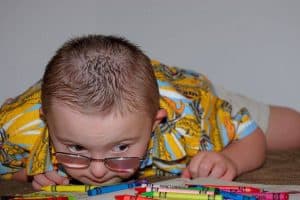Does my Baby have a Vision Problem?
Infant eye exams are essential to ensure your baby’s visual development meets their developmental milestones. Most baby’s eyes are assessed by a neonatologist within a
Read More2021 Update: Lazy Eye and Adults
Lazy eye is estimated to affect up to 5% of all adults. For many decades, it has been thought that only children under the age
Read MoreIs there a Link between Visual Skills and Reading?
We thank Dr Dan Fortenbacher for the context of this blog. This is based on Dr Dan’s blog on the VisionHelp website; ‘The importance of
Read MoreVision and Autism: Part 2
Author: Randy Schulman, MS, OD, FCOVD As vision is key to so many other systems, vision intervention, such as vision therapy, can have a profound
Read MoreVision and Autism: Part 1
Author: Randy Schulman, MS, OD, FCOVD This year marks my 30th year as an optometrist and during all of those years I have seen thousands
Read MoreNearsighted or Farsighted?
Have you been told you are ‘nearsighted’ or ‘farsighted’ but not totally sure what they mean? Both of these may require you to rely on
Read MoreWhat to Do Before an Eye Exam?
About to come in for your eye exam? To get the most out of your visit, start preparing with these 4 tips. If you’re experiencing
Read MoreBuilding Self Esteem
Too many children are labelled as lazy learners, poor students, learning difficulty and even dyslexia and ADHD, when it could be an undiagnosed vision problem.
Read MoreWhat Are the Signs You Need Vision Therapy?
Are you concerned with your performance at school, work, or sports? Strengthening the visual skills boosts your ability to focus, read, concentrate and all other aspects required for work performance. Vision therapy is a customized, personalized treatment program designed to strengthen and improve visual skills, resulting in enhanced reading, learning, attention and the overall school performances.
Read MoreCould a Child with ‘20/20 Sight’ Have a Vision Problem?
Studies have found that 1 out of 4 school children suffer from a vision problem that impacts their learning. If your child has 20/20 vision,
Read MoreCould Your Child Have Digital Eye Strain?
Since 2010, there has been a 70% increase of smartphone usage and 40% increase in laptop usage worldwide. Eye doctors are reporting a major increase
Read MoreCould Eye Strain Impact your Work Performance?
Do you feel your work performance is impacted by tiredness, headaches or eye strain?
Vision therapy may just be the solution you have been searching for.
Vision therapy is an effective customized program that can deliver clearer and more comfortable vision. Vision therapy has been clinically proven to be effective for adults too.
Contact Lenses for Astigmatism
Approximately 1 in 3 people have astigmatism, a vision condition that causes blurry and distorted vision. If you have astigmatism, there is a wide variety
Read MoreThe Contact Lens Exam
Over 22 percent of people who wear eyeglasses enjoy the benefits of also using contact lenses. If you are thinking about contact lenses, a contact
Read MoreGuide to Hard Contact Lenses
While soft contact lenses have become quite popular in recent years, hard contact lenses are actually preferred by many people with specific vision conditions
Read MoreGuide to Soft Contact Lenses
Approximately 90 percent of contact lens wearers prefer soft contact lenses. There are many different options when it comes to soft contact lenses. While your optometrist can help you to narrow down your choices— usually dependent on your prescription and personal lifestyle, it is important to be aware of the advantages and disadvantages of each type of lens
Read MoreWhat is Laser Refractive Surgery?
Are you thinking of having laser eye surgery? Laser eye surgery, also called laser refractive surgery, is a common procedure that is performed to eliminate the need for eye wear— both glasses and contact lenses. Up to 98 percent of patients achieve 20/20 vision with laser eye surgery.
Read MoreGuide to Bifocals and Multifocals
Have you noticed the need to hold your phone, books or restaurant menus farther from your eyes to improve their clarity? Presbyopia is the most common reason most adults begin to wear eyeglasses. The condition generally develops overtime, beginning at around age 40, and is considered a normal part of the aging process.
Read MoreOptical Lenses
In recent years, the transition from glass to plastic lenses has revolutionized the way we see. In the past, eyeglass lenses were made of glass. However, in recent years, lenses have transitioned to a durable plastic, that is lighter in weight, and less prone to breaking— providing a more comfortable experience.
Read MoreOptical Frames
Shopping for eyeglass frames can be quite overwhelming… but also lots of fun! Eyeglasses nowadays come in a variety of styles, shapes, colors, and materials— metal, plastic, and even natural wood. Optical stores are filled with rows and rows of frames, manufactured by popular brands and designers to suit every taste and unique fashion sense.
Read MoreEyecare for Children
Eyecare for Children Are you worried about your child needing glasses? Do you want to understand why your child needs bifocals or multifocals? Are you
Read MoreHypertropia or Hyperphoria?
Hypertropia and hyperphoria are when the eyes are misaligned – one pointing higher than the other. Both these forms of eye turn can be well managed by optical lenses and vision therapy, often avoiding eye surgery.
Read MoreVision for Special Needs
Children with special needs have a high rate of visual problems and their lives can be enhanced with the correct eye care. Vision therapy has also been shown to improve the visual skills to improve eye contact and interactions with their surroundings – significantly enhancing their lives.
Read MoreVision Therapy for Lazy Eye
Lazy eye is a common vision problem, affecting up to 1 in 20 (5%) of all children. Has your child been treated for lazy eye, yet the vision remains poor? Lazy eye can be successfully treated for both children and adults, with new digital techniques using computer-based 3D games.
Read MoreVision Therapy for Children
Are your child’s school grades not a true reflection of their potential? Has your child been told they have a learning or attention difficulties?
The problem could be with their eyes or visual skills and vision therapy might the solution you have been looking for.
What Is Farsightedness?
It is estimated that 13% of school age children are far-sighted, farsightedness, also known as long-sightedness or hyperopia, causes near objects or images to appear blurry. Hyperopia causes the eye to focus what you are looking at behind the retina, instead of on the retina- causing words on a page, or images on your phone to appear out of focus.
Read MoreDo Children Need Sunglasses?
We all appreciate the need to protect our skin and eyes from harmful ultraviolet (UV) radiation— this is even more important for children! Your child’s
Read MoreWhat Are ‘Low Plus’ Lenses?
Why did your eye doctor prescribe ‘low plus’ lenses for your child? Low plus lenses, like their name suggests, have relatively low lens powers usually +0.50, +0.75 or +1.00. These powers are considered ‘low’, but may have a considerable benefit for your child’s reading and school grades.
Read MoreAre School Vision Screenings Reliable?
Many schools conduct vision screenings as a service to try to identify vision problems, but are they reliable? The simple answer is, no. These vision screenings are very limited, and are not a substitute for a comprehensive eye examination performed by an eye doctor.
Read MorePost Trauma Vision Syndrome
A Guide to Post Trauma Vision Syndrome Author: Dr. Allen Cohen OD, FCOVD Dr. Cohen is currently Clinical Professor of Optometry, SUNY State College of
Read MoreVision and Down Syndrome
The frequency of Down Syndrome (DS) is approximately 1 in every 800 births, with an increased frequency among older mothers. With the specialized improvements in the quality of eye care individuals with DS can live a more productive, longer life. Individuals with Down Syndrome (DS) are at a higher risk for a range of vision conditions that may affect the development of their visual skills.
Read MoreWhat Is Esotropia?
Esotropia is a form of strabismus (crossed-eyes) that is caused by an inward turn of the eye, toward the nose. This condition can be constant or intermittent and cause an individual to appear ‘cross-eyed’.
Read More





























